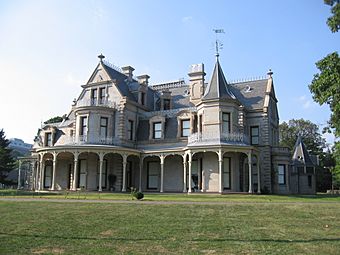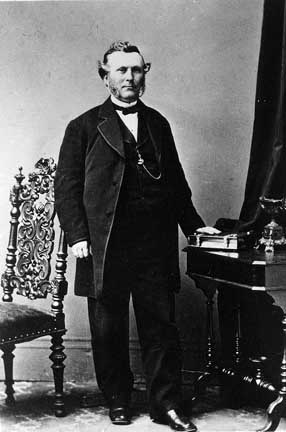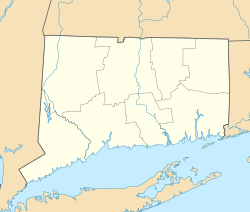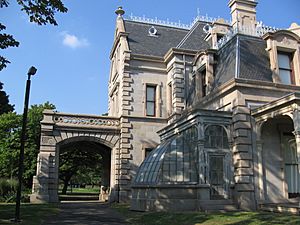Lockwood–Mathews Mansion facts for kids
|
Lockwood–Mathews Mansion
|
|

South side of the mansion
|
|
| Location | 295 West Avenue, Norwalk, Connecticut |
|---|---|
| Built | 1864 |
| Architect | Detlef Lienau |
| Architectural style | Second Empire |
| NRHP reference No. | 70000836 |
Quick facts for kids Significant dates |
|
| Added to NRHP | December 30, 1970 |
| Designated NHL | December 30, 1970 |
The Lockwood–Mathews Mansion is a grand country house in Norwalk, Connecticut. It was built in the Second Empire style, which was popular in the 1800s. This amazing house was finished in 1868 for LeGrand Lockwood, a very rich man who made his money in railroads and banking.
Today, the mansion is a museum. It has 62 rooms and is about 4,088 square meters (44,000 square feet) in size. Because of its importance, it was added to the National Register of Historic Places. It was also named a National Historic Landmark in 1978. Many people say it is one of the best and earliest examples of a Second Empire style house in the United States. You can find it at 295 West Avenue, inside Mathews Park. The Stepping Stones Museum for Children is also located nearby.
History of the Mansion
A Family Home

The Lockwood–Mathews Mansion was built on a large property once called "Elm Park." LeGrand Lockwood, who earned a lot of money from banking and railroads, owned this estate. Building the house started in 1864, just west of the Norwalk River in Norwalk. It took four years to complete this huge home.
The mansion was designed by Detlef Lienau, an architect who trained in Europe. The house has about 2,453 square meters (26,402 square feet) of living space. It is thought to be Lienau's most important work that still exists today. Both American and immigrant artists and builders worked together to create and decorate the mansion. Famous decorating companies from New York, like Herter Brothers, helped furnish the inside of the house.
Sadly, LeGrand Lockwood faced money problems in 1869. He passed away in 1872. Because of this, his family lost the estate in 1874. In 1876, Charles D. Mathews and his wife, Rebecca Thompson Mathews, bought the property. Charles Mathews was a very wealthy retired food dealer from New York. The mansion became a home and a quiet getaway for the Mathews family and their relatives. They lived there until Charles's daughter, Florence, passed away in 1938.
Becoming a Museum
The Lockwood–Mathews Mansion was built between 1864 and 1868. It was one of the first homes of its kind. Wealthy families from New York City, like the Vanderbilt family, later built similar grand mansions during the Gilded Age. This mansion set a new standard for how fancy and rich a home could be.
In 1941, the City of Norwalk bought the estate. They decided to make it a public park. However, in 1959, the city planned to build a city hall in the park. This would have meant tearing down the mansion. Many people were upset about this plan.
Local groups who wanted to save old buildings stepped in. They formed an organization called Lockwood–Mathews Mansion Museum, Inc. This group worked to protect the mansion. In the late 1960s, the Junior League of Stamford-Norwalk led a big effort to restore the house. They received help from many important groups, including the National Trust for Historic Preservation. Because of these efforts, the home was named a National Historic Landmark in 1971.
The museum's goal is to keep the building safe and beautiful. They also create educational programs about life, art, and society during the Victorian era. In the 2000s, some of the original statues and furniture were bought back and returned to the mansion. For example, two marble statues made in 1859 by an American artist named Joseph Mozier were bought for $185,000. A sofa that was originally in the home was also bought back for $165,000.
A big plan for a full restoration of the mansion was finished in 2008. This plan included adding an elevator, heating, air conditioning, and sprinklers. The museum closed for a year in 2023 for these important upgrades. This project cost $18 million in total. It included a new HVAC system (for heating and cooling), a fire suppression system, new lights, and Wi-Fi. The museum is set to reopen on June 4, 2025, and a special ceremony was held on May 27, 2025.
Fun Programs and Events
The Lockwood–Mathews Mansion hosts many exciting events.
- Every Christmas, interior decorators decorate about a dozen rooms in the mansion for the holidays.
- An annual "community celebration" takes place in December. It features Christmas music, snacks, and a visit from Santa Claus. In 2007, ten decorators volunteered their time and materials for this event.
- The museum has also hosted an annual antique show since 1978. In 2006, this show brought dealers from different states to Norwalk.
See also




